Effects of Temperature, pH, and Agitation on AMP Activity of S. Warnerii
VerifiedAdded on 2023/04/08
|10
|2119
|443
AI Summary
This study examines the effects of temperature, pH control, and agitation on the AMP activity of Staphylococcus Warnerii. It explores the fermentation process, bacterial growth phases, and the production of bacteriocins. The results show the impact of temperature, pH, and agitation on cell activity and peptide production.
Contribute Materials
Your contribution can guide someone’s learning journey. Share your
documents today.
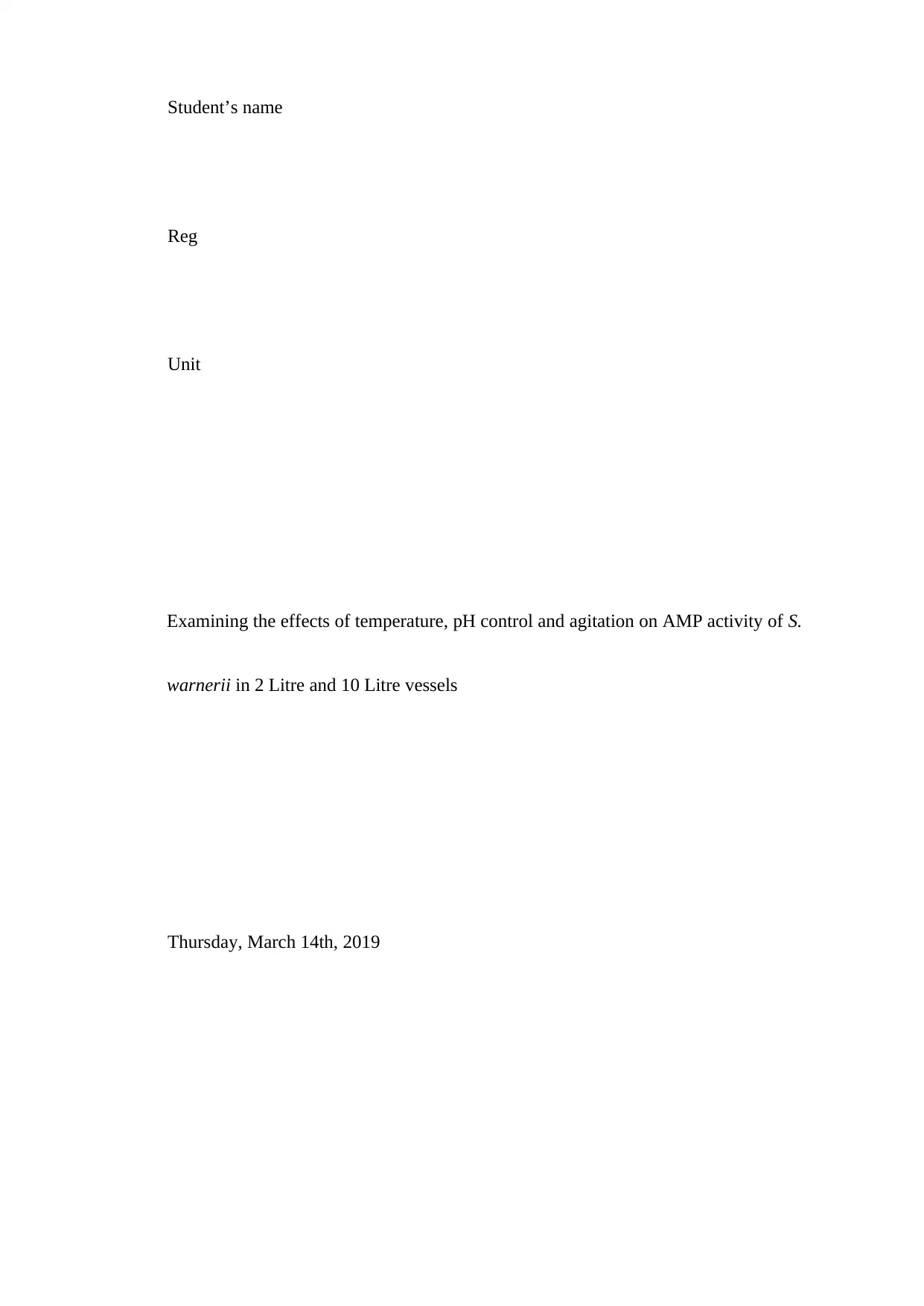
Student’s name
Reg
Unit
Examining the effects of temperature, pH control and agitation on AMP activity of S.
warnerii in 2 Litre and 10 Litre vessels
Thursday, March 14th, 2019
Reg
Unit
Examining the effects of temperature, pH control and agitation on AMP activity of S.
warnerii in 2 Litre and 10 Litre vessels
Thursday, March 14th, 2019
Secure Best Marks with AI Grader
Need help grading? Try our AI Grader for instant feedback on your assignments.
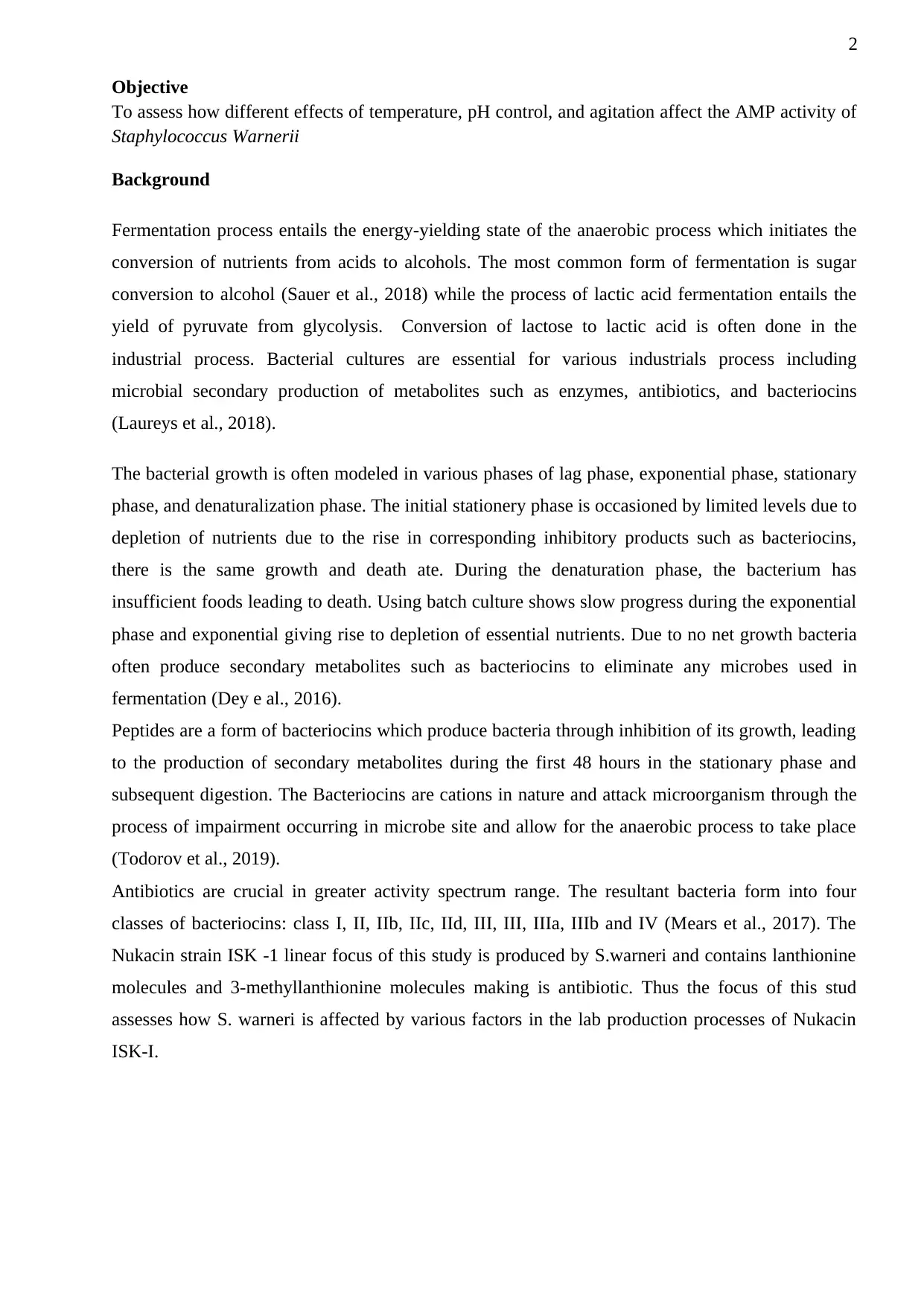
2
Objective
To assess how different effects of temperature, pH control, and agitation affect the AMP activity of
Staphylococcus Warnerii
Background
Fermentation process entails the energy-yielding state of the anaerobic process which initiates the
conversion of nutrients from acids to alcohols. The most common form of fermentation is sugar
conversion to alcohol (Sauer et al., 2018) while the process of lactic acid fermentation entails the
yield of pyruvate from glycolysis. Conversion of lactose to lactic acid is often done in the
industrial process. Bacterial cultures are essential for various industrials process including
microbial secondary production of metabolites such as enzymes, antibiotics, and bacteriocins
(Laureys et al., 2018).
The bacterial growth is often modeled in various phases of lag phase, exponential phase, stationary
phase, and denaturalization phase. The initial stationery phase is occasioned by limited levels due to
depletion of nutrients due to the rise in corresponding inhibitory products such as bacteriocins,
there is the same growth and death ate. During the denaturation phase, the bacterium has
insufficient foods leading to death. Using batch culture shows slow progress during the exponential
phase and exponential giving rise to depletion of essential nutrients. Due to no net growth bacteria
often produce secondary metabolites such as bacteriocins to eliminate any microbes used in
fermentation (Dey e al., 2016).
Peptides are a form of bacteriocins which produce bacteria through inhibition of its growth, leading
to the production of secondary metabolites during the first 48 hours in the stationary phase and
subsequent digestion. The Bacteriocins are cations in nature and attack microorganism through the
process of impairment occurring in microbe site and allow for the anaerobic process to take place
(Todorov et al., 2019).
Antibiotics are crucial in greater activity spectrum range. The resultant bacteria form into four
classes of bacteriocins: class I, II, IIb, IIc, IId, III, III, IIIa, IIIb and IV (Mears et al., 2017). The
Nukacin strain ISK -1 linear focus of this study is produced by S.warneri and contains lanthionine
molecules and 3-methyllanthionine molecules making is antibiotic. Thus the focus of this stud
assesses how S. warneri is affected by various factors in the lab production processes of Nukacin
ISK-I.
Objective
To assess how different effects of temperature, pH control, and agitation affect the AMP activity of
Staphylococcus Warnerii
Background
Fermentation process entails the energy-yielding state of the anaerobic process which initiates the
conversion of nutrients from acids to alcohols. The most common form of fermentation is sugar
conversion to alcohol (Sauer et al., 2018) while the process of lactic acid fermentation entails the
yield of pyruvate from glycolysis. Conversion of lactose to lactic acid is often done in the
industrial process. Bacterial cultures are essential for various industrials process including
microbial secondary production of metabolites such as enzymes, antibiotics, and bacteriocins
(Laureys et al., 2018).
The bacterial growth is often modeled in various phases of lag phase, exponential phase, stationary
phase, and denaturalization phase. The initial stationery phase is occasioned by limited levels due to
depletion of nutrients due to the rise in corresponding inhibitory products such as bacteriocins,
there is the same growth and death ate. During the denaturation phase, the bacterium has
insufficient foods leading to death. Using batch culture shows slow progress during the exponential
phase and exponential giving rise to depletion of essential nutrients. Due to no net growth bacteria
often produce secondary metabolites such as bacteriocins to eliminate any microbes used in
fermentation (Dey e al., 2016).
Peptides are a form of bacteriocins which produce bacteria through inhibition of its growth, leading
to the production of secondary metabolites during the first 48 hours in the stationary phase and
subsequent digestion. The Bacteriocins are cations in nature and attack microorganism through the
process of impairment occurring in microbe site and allow for the anaerobic process to take place
(Todorov et al., 2019).
Antibiotics are crucial in greater activity spectrum range. The resultant bacteria form into four
classes of bacteriocins: class I, II, IIb, IIc, IId, III, III, IIIa, IIIb and IV (Mears et al., 2017). The
Nukacin strain ISK -1 linear focus of this study is produced by S.warneri and contains lanthionine
molecules and 3-methyllanthionine molecules making is antibiotic. Thus the focus of this stud
assesses how S. warneri is affected by various factors in the lab production processes of Nukacin
ISK-I.
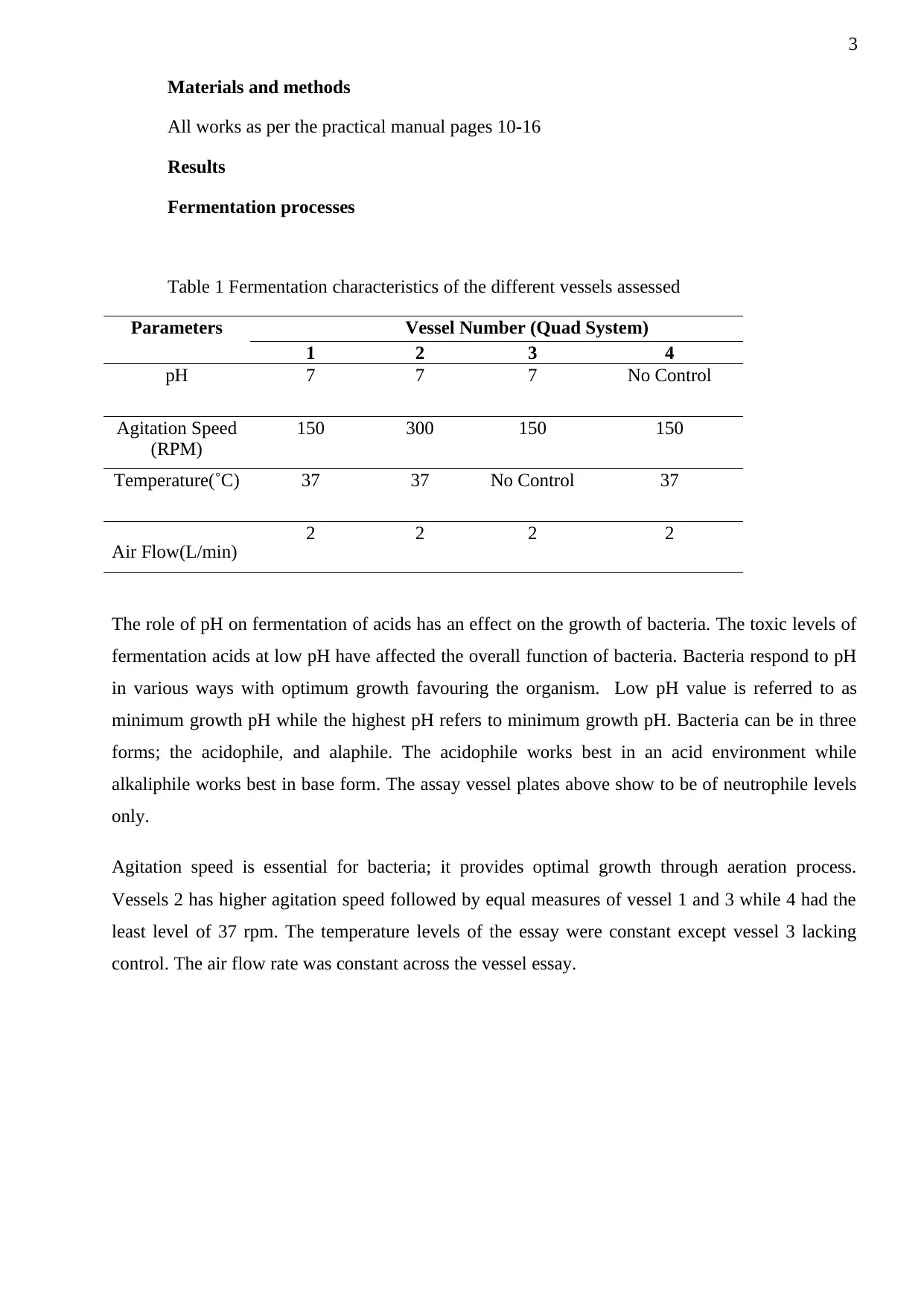
3
Materials and methods
All works as per the practical manual pages 10-16
Results
Fermentation processes
Table 1 Fermentation characteristics of the different vessels assessed
Parameters Vessel Number (Quad System)
1 2 3 4
pH 7 7 7 No Control
Agitation Speed
(RPM)
150 300 150 150
Temperature(˚C) 37 37 No Control 37
Air Flow(L/min) 2 2 2 2
The role of pH on fermentation of acids has an effect on the growth of bacteria. The toxic levels of
fermentation acids at low pH have affected the overall function of bacteria. Bacteria respond to pH
in various ways with optimum growth favouring the organism. Low pH value is referred to as
minimum growth pH while the highest pH refers to minimum growth pH. Bacteria can be in three
forms; the acidophile, and alaphile. The acidophile works best in an acid environment while
alkaliphile works best in base form. The assay vessel plates above show to be of neutrophile levels
only.
Agitation speed is essential for bacteria; it provides optimal growth through aeration process.
Vessels 2 has higher agitation speed followed by equal measures of vessel 1 and 3 while 4 had the
least level of 37 rpm. The temperature levels of the essay were constant except vessel 3 lacking
control. The air flow rate was constant across the vessel essay.
Materials and methods
All works as per the practical manual pages 10-16
Results
Fermentation processes
Table 1 Fermentation characteristics of the different vessels assessed
Parameters Vessel Number (Quad System)
1 2 3 4
pH 7 7 7 No Control
Agitation Speed
(RPM)
150 300 150 150
Temperature(˚C) 37 37 No Control 37
Air Flow(L/min) 2 2 2 2
The role of pH on fermentation of acids has an effect on the growth of bacteria. The toxic levels of
fermentation acids at low pH have affected the overall function of bacteria. Bacteria respond to pH
in various ways with optimum growth favouring the organism. Low pH value is referred to as
minimum growth pH while the highest pH refers to minimum growth pH. Bacteria can be in three
forms; the acidophile, and alaphile. The acidophile works best in an acid environment while
alkaliphile works best in base form. The assay vessel plates above show to be of neutrophile levels
only.
Agitation speed is essential for bacteria; it provides optimal growth through aeration process.
Vessels 2 has higher agitation speed followed by equal measures of vessel 1 and 3 while 4 had the
least level of 37 rpm. The temperature levels of the essay were constant except vessel 3 lacking
control. The air flow rate was constant across the vessel essay.
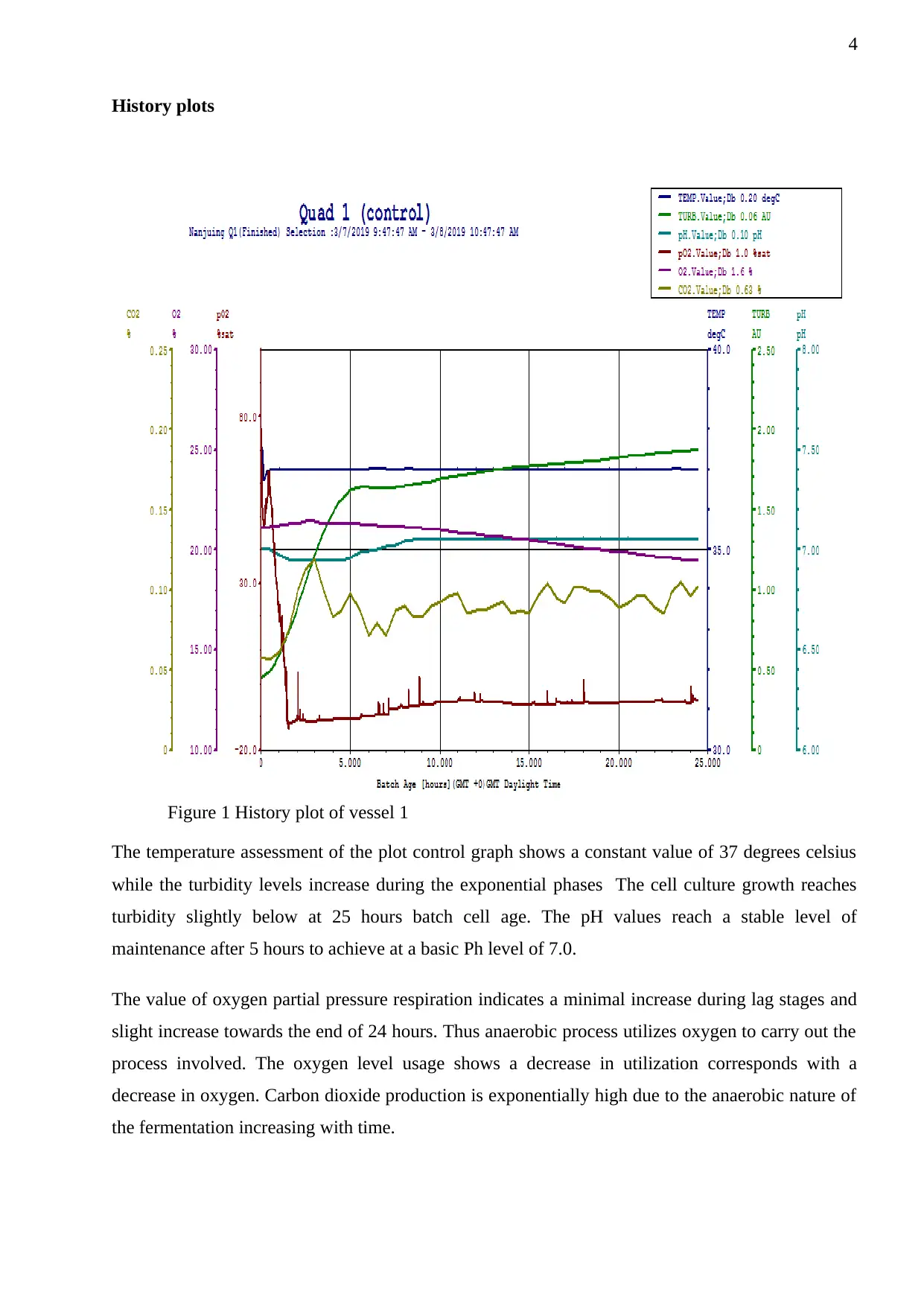
4
History plots
Figure 1 History plot of vessel 1
The temperature assessment of the plot control graph shows a constant value of 37 degrees celsius
while the turbidity levels increase during the exponential phases The cell culture growth reaches
turbidity slightly below at 25 hours batch cell age. The pH values reach a stable level of
maintenance after 5 hours to achieve at a basic Ph level of 7.0.
The value of oxygen partial pressure respiration indicates a minimal increase during lag stages and
slight increase towards the end of 24 hours. Thus anaerobic process utilizes oxygen to carry out the
process involved. The oxygen level usage shows a decrease in utilization corresponds with a
decrease in oxygen. Carbon dioxide production is exponentially high due to the anaerobic nature of
the fermentation increasing with time.
History plots
Figure 1 History plot of vessel 1
The temperature assessment of the plot control graph shows a constant value of 37 degrees celsius
while the turbidity levels increase during the exponential phases The cell culture growth reaches
turbidity slightly below at 25 hours batch cell age. The pH values reach a stable level of
maintenance after 5 hours to achieve at a basic Ph level of 7.0.
The value of oxygen partial pressure respiration indicates a minimal increase during lag stages and
slight increase towards the end of 24 hours. Thus anaerobic process utilizes oxygen to carry out the
process involved. The oxygen level usage shows a decrease in utilization corresponds with a
decrease in oxygen. Carbon dioxide production is exponentially high due to the anaerobic nature of
the fermentation increasing with time.
Secure Best Marks with AI Grader
Need help grading? Try our AI Grader for instant feedback on your assignments.
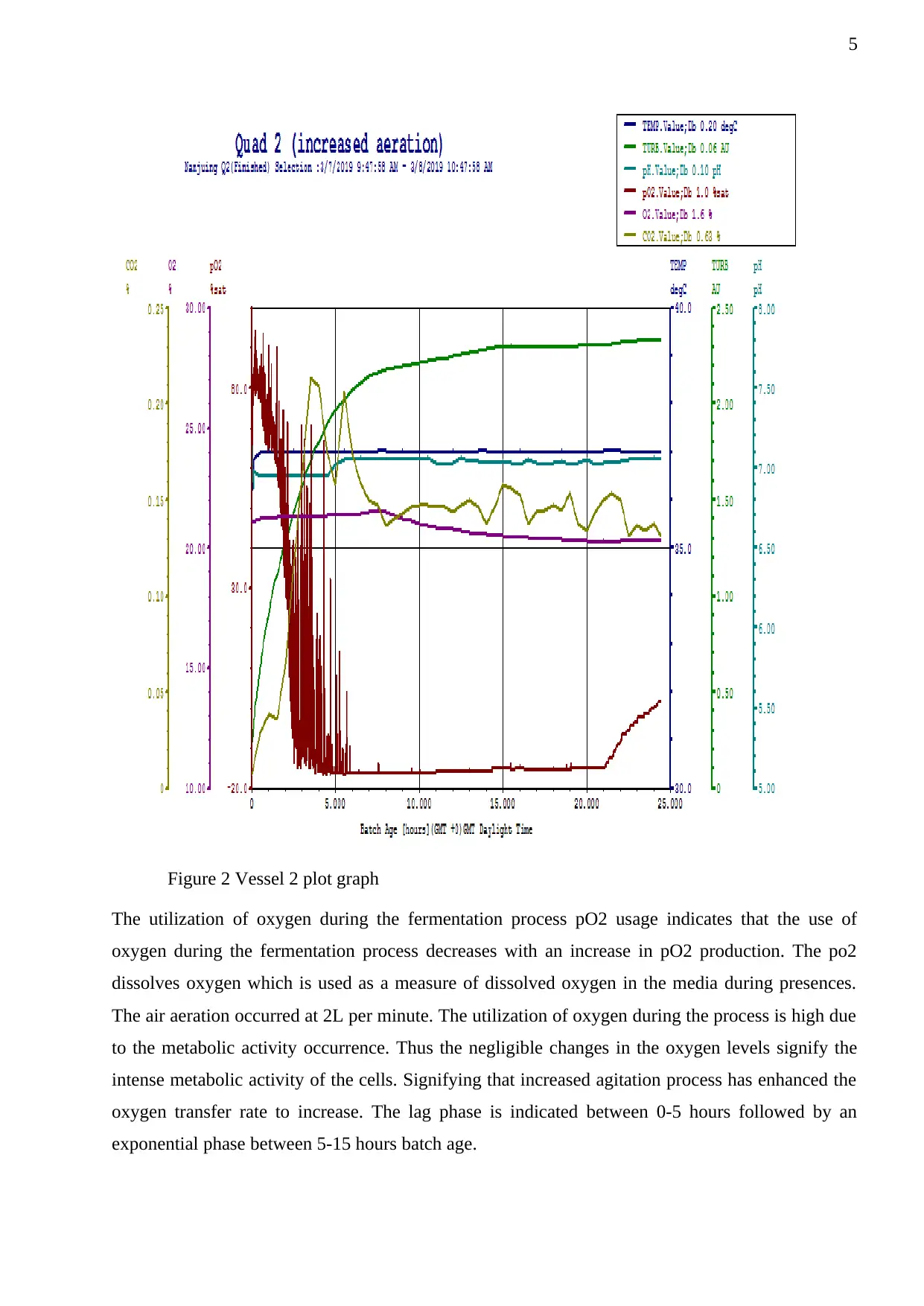
5
Figure 2 Vessel 2 plot graph
The utilization of oxygen during the fermentation process pO2 usage indicates that the use of
oxygen during the fermentation process decreases with an increase in pO2 production. The po2
dissolves oxygen which is used as a measure of dissolved oxygen in the media during presences.
The air aeration occurred at 2L per minute. The utilization of oxygen during the process is high due
to the metabolic activity occurrence. Thus the negligible changes in the oxygen levels signify the
intense metabolic activity of the cells. Signifying that increased agitation process has enhanced the
oxygen transfer rate to increase. The lag phase is indicated between 0-5 hours followed by an
exponential phase between 5-15 hours batch age.
Figure 2 Vessel 2 plot graph
The utilization of oxygen during the fermentation process pO2 usage indicates that the use of
oxygen during the fermentation process decreases with an increase in pO2 production. The po2
dissolves oxygen which is used as a measure of dissolved oxygen in the media during presences.
The air aeration occurred at 2L per minute. The utilization of oxygen during the process is high due
to the metabolic activity occurrence. Thus the negligible changes in the oxygen levels signify the
intense metabolic activity of the cells. Signifying that increased agitation process has enhanced the
oxygen transfer rate to increase. The lag phase is indicated between 0-5 hours followed by an
exponential phase between 5-15 hours batch age.
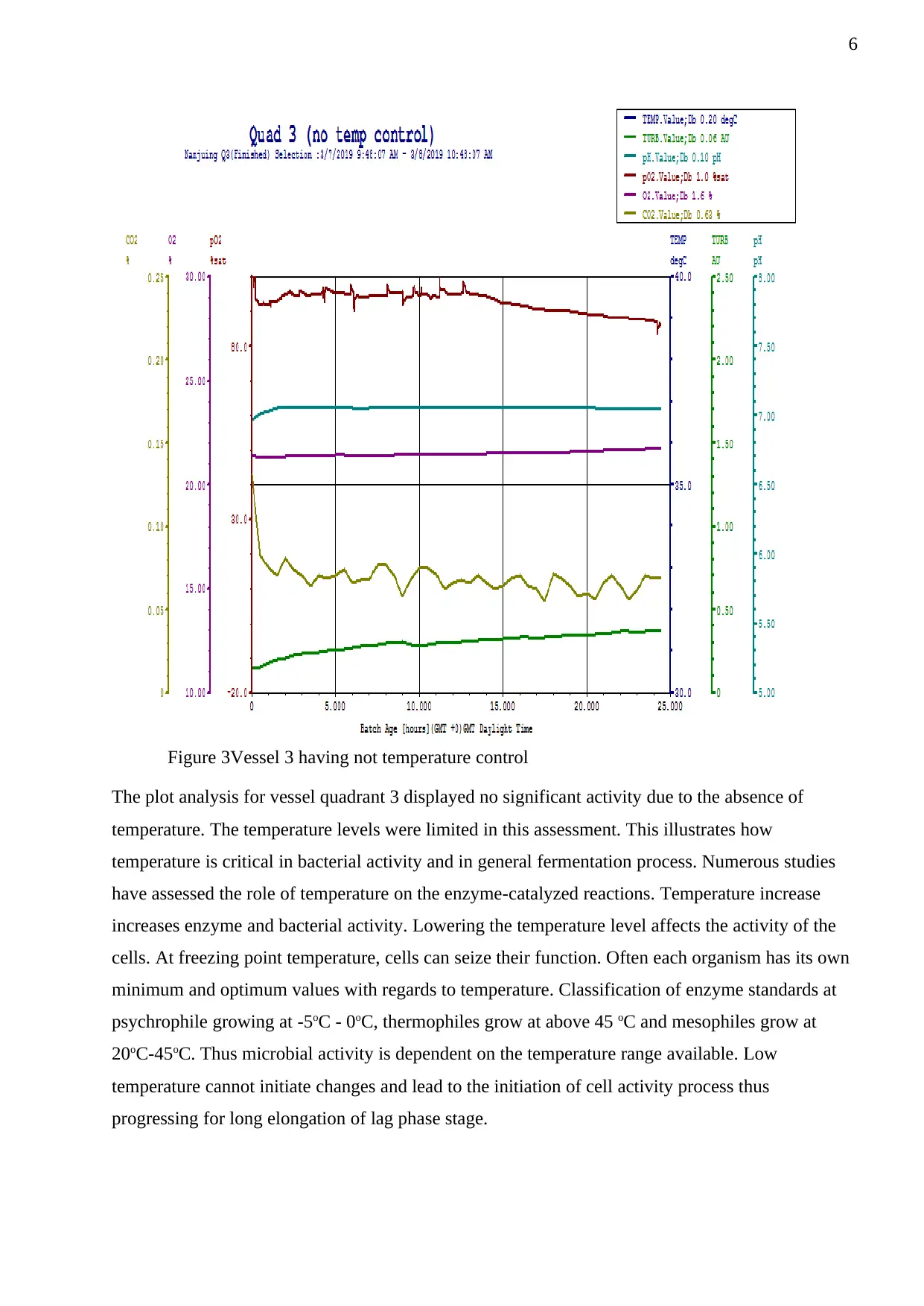
6
Figure 3Vessel 3 having not temperature control
The plot analysis for vessel quadrant 3 displayed no significant activity due to the absence of
temperature. The temperature levels were limited in this assessment. This illustrates how
temperature is critical in bacterial activity and in general fermentation process. Numerous studies
have assessed the role of temperature on the enzyme-catalyzed reactions. Temperature increase
increases enzyme and bacterial activity. Lowering the temperature level affects the activity of the
cells. At freezing point temperature, cells can seize their function. Often each organism has its own
minimum and optimum values with regards to temperature. Classification of enzyme standards at
psychrophile growing at -5oC - 0oC, thermophiles grow at above 45 oC and mesophiles grow at
20oC-45oC. Thus microbial activity is dependent on the temperature range available. Low
temperature cannot initiate changes and lead to the initiation of cell activity process thus
progressing for long elongation of lag phase stage.
Figure 3Vessel 3 having not temperature control
The plot analysis for vessel quadrant 3 displayed no significant activity due to the absence of
temperature. The temperature levels were limited in this assessment. This illustrates how
temperature is critical in bacterial activity and in general fermentation process. Numerous studies
have assessed the role of temperature on the enzyme-catalyzed reactions. Temperature increase
increases enzyme and bacterial activity. Lowering the temperature level affects the activity of the
cells. At freezing point temperature, cells can seize their function. Often each organism has its own
minimum and optimum values with regards to temperature. Classification of enzyme standards at
psychrophile growing at -5oC - 0oC, thermophiles grow at above 45 oC and mesophiles grow at
20oC-45oC. Thus microbial activity is dependent on the temperature range available. Low
temperature cannot initiate changes and lead to the initiation of cell activity process thus
progressing for long elongation of lag phase stage.
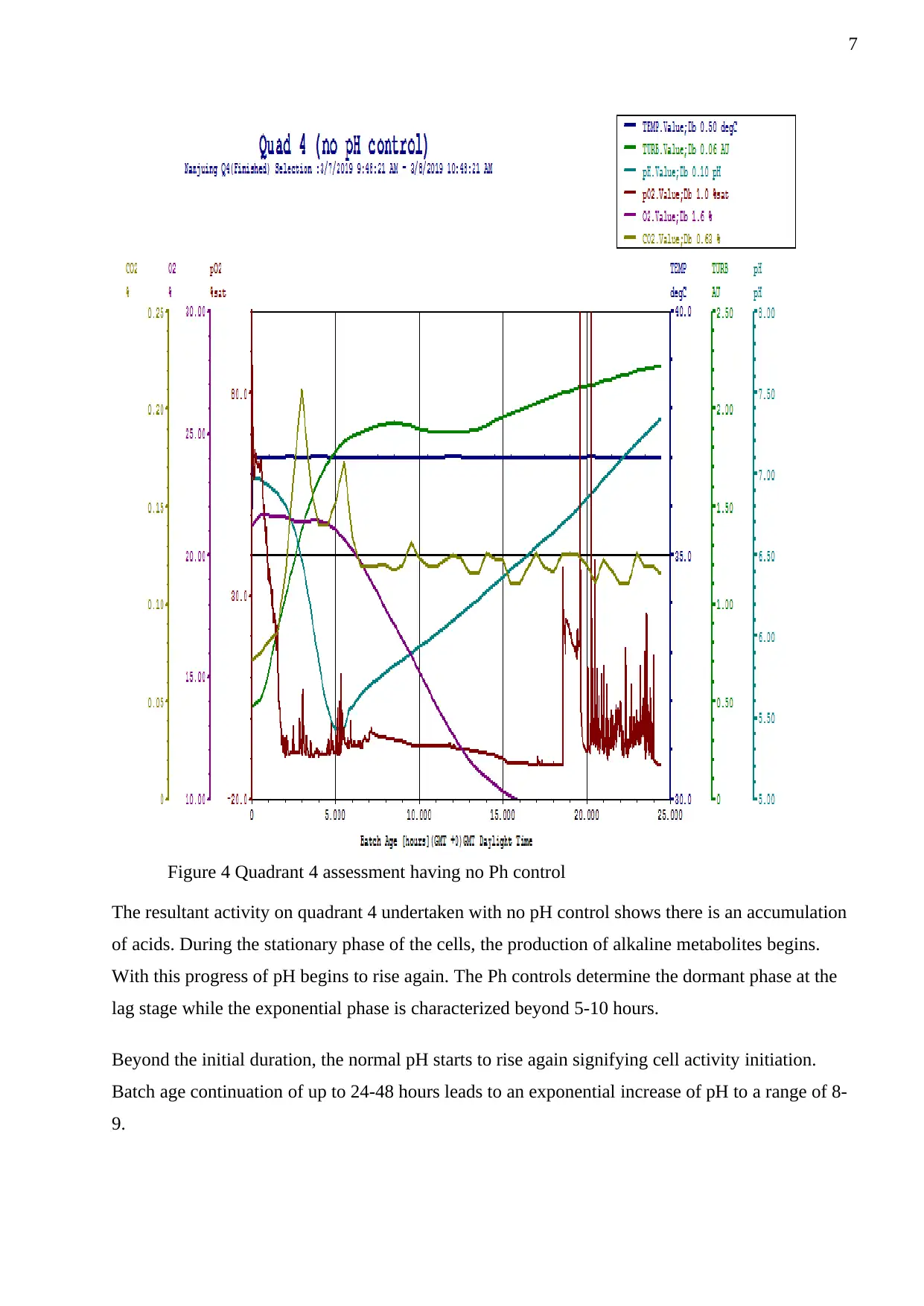
7
Figure 4 Quadrant 4 assessment having no Ph control
The resultant activity on quadrant 4 undertaken with no pH control shows there is an accumulation
of acids. During the stationary phase of the cells, the production of alkaline metabolites begins.
With this progress of pH begins to rise again. The Ph controls determine the dormant phase at the
lag stage while the exponential phase is characterized beyond 5-10 hours.
Beyond the initial duration, the normal pH starts to rise again signifying cell activity initiation.
Batch age continuation of up to 24-48 hours leads to an exponential increase of pH to a range of 8-
9.
Figure 4 Quadrant 4 assessment having no Ph control
The resultant activity on quadrant 4 undertaken with no pH control shows there is an accumulation
of acids. During the stationary phase of the cells, the production of alkaline metabolites begins.
With this progress of pH begins to rise again. The Ph controls determine the dormant phase at the
lag stage while the exponential phase is characterized beyond 5-10 hours.
Beyond the initial duration, the normal pH starts to rise again signifying cell activity initiation.
Batch age continuation of up to 24-48 hours leads to an exponential increase of pH to a range of 8-
9.
Paraphrase This Document
Need a fresh take? Get an instant paraphrase of this document with our AI Paraphraser
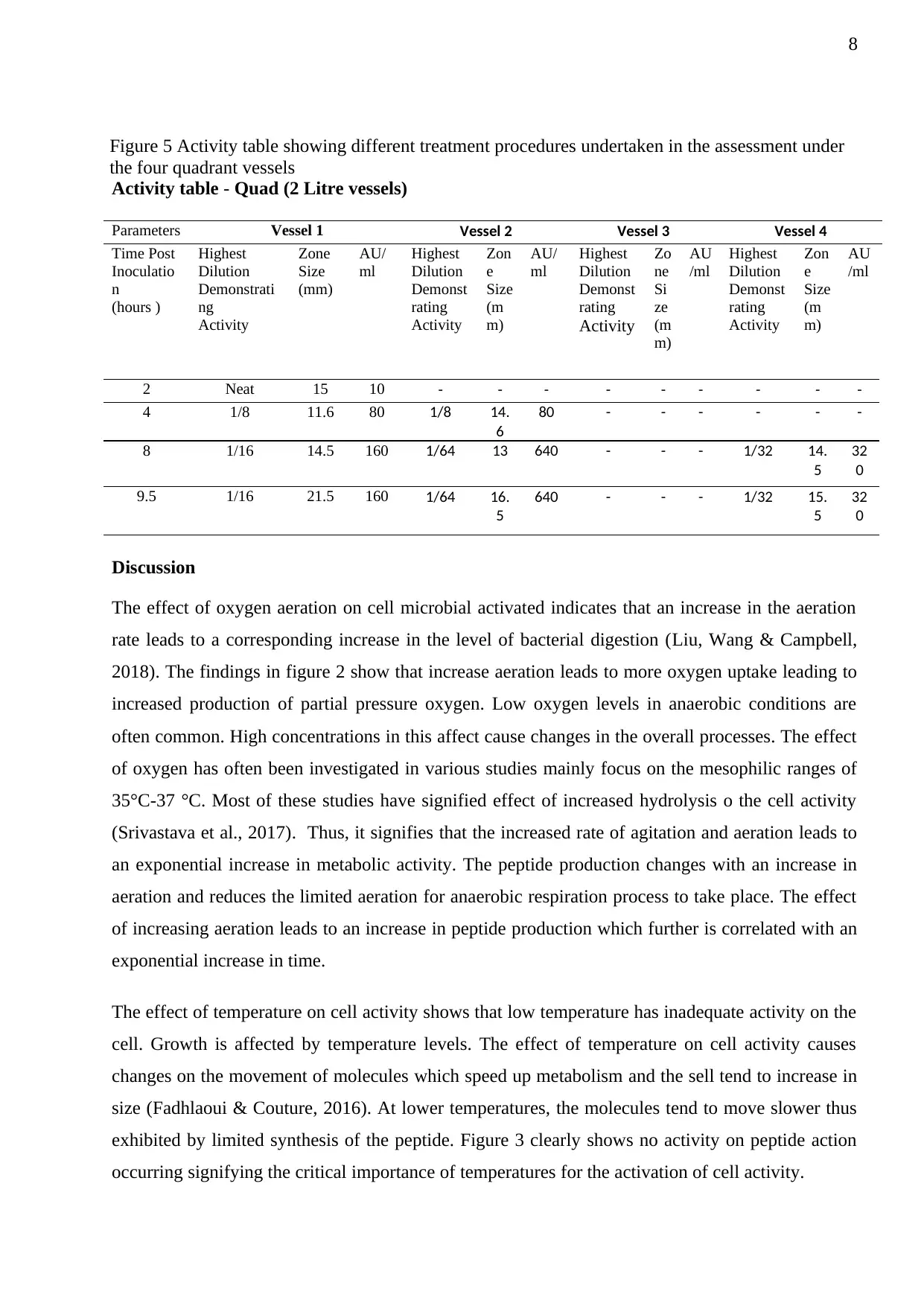
8
Activity table - Quad (2 Litre vessels)
Parameters Vessel 1 Vessel 2 Vessel 3 Vessel 4
Time Post
Inoculatio
n
(hours )
Highest
Dilution
Demonstrati
ng
Activity
Zone
Size
(mm)
AU/
ml
Highest
Dilution
Demonst
rating
Activity
Zon
e
Size
(m
m)
AU/
ml
Highest
Dilution
Demonst
rating
Activity
Zo
ne
Si
ze
(m
m)
AU
/ml
Highest
Dilution
Demonst
rating
Activity
Zon
e
Size
(m
m)
AU
/ml
2 Neat 15 10 - - - - - - - - -
4 1/8 11.6 80 1/8 14.
6
80 - - - - - -
8 1/16 14.5 160 1/64 13 640 - - - 1/32 14.
5
32
0
9.5 1/16 21.5 160 1/64 16.
5
640 - - - 1/32 15.
5
32
0
Discussion
The effect of oxygen aeration on cell microbial activated indicates that an increase in the aeration
rate leads to a corresponding increase in the level of bacterial digestion (Liu, Wang & Campbell,
2018). The findings in figure 2 show that increase aeration leads to more oxygen uptake leading to
increased production of partial pressure oxygen. Low oxygen levels in anaerobic conditions are
often common. High concentrations in this affect cause changes in the overall processes. The effect
of oxygen has often been investigated in various studies mainly focus on the mesophilic ranges of
35°C-37 °C. Most of these studies have signified effect of increased hydrolysis o the cell activity
(Srivastava et al., 2017). Thus, it signifies that the increased rate of agitation and aeration leads to
an exponential increase in metabolic activity. The peptide production changes with an increase in
aeration and reduces the limited aeration for anaerobic respiration process to take place. The effect
of increasing aeration leads to an increase in peptide production which further is correlated with an
exponential increase in time.
The effect of temperature on cell activity shows that low temperature has inadequate activity on the
cell. Growth is affected by temperature levels. The effect of temperature on cell activity causes
changes on the movement of molecules which speed up metabolism and the sell tend to increase in
size (Fadhlaoui & Couture, 2016). At lower temperatures, the molecules tend to move slower thus
exhibited by limited synthesis of the peptide. Figure 3 clearly shows no activity on peptide action
occurring signifying the critical importance of temperatures for the activation of cell activity.
Figure 5 Activity table showing different treatment procedures undertaken in the assessment under
the four quadrant vessels
Activity table - Quad (2 Litre vessels)
Parameters Vessel 1 Vessel 2 Vessel 3 Vessel 4
Time Post
Inoculatio
n
(hours )
Highest
Dilution
Demonstrati
ng
Activity
Zone
Size
(mm)
AU/
ml
Highest
Dilution
Demonst
rating
Activity
Zon
e
Size
(m
m)
AU/
ml
Highest
Dilution
Demonst
rating
Activity
Zo
ne
Si
ze
(m
m)
AU
/ml
Highest
Dilution
Demonst
rating
Activity
Zon
e
Size
(m
m)
AU
/ml
2 Neat 15 10 - - - - - - - - -
4 1/8 11.6 80 1/8 14.
6
80 - - - - - -
8 1/16 14.5 160 1/64 13 640 - - - 1/32 14.
5
32
0
9.5 1/16 21.5 160 1/64 16.
5
640 - - - 1/32 15.
5
32
0
Discussion
The effect of oxygen aeration on cell microbial activated indicates that an increase in the aeration
rate leads to a corresponding increase in the level of bacterial digestion (Liu, Wang & Campbell,
2018). The findings in figure 2 show that increase aeration leads to more oxygen uptake leading to
increased production of partial pressure oxygen. Low oxygen levels in anaerobic conditions are
often common. High concentrations in this affect cause changes in the overall processes. The effect
of oxygen has often been investigated in various studies mainly focus on the mesophilic ranges of
35°C-37 °C. Most of these studies have signified effect of increased hydrolysis o the cell activity
(Srivastava et al., 2017). Thus, it signifies that the increased rate of agitation and aeration leads to
an exponential increase in metabolic activity. The peptide production changes with an increase in
aeration and reduces the limited aeration for anaerobic respiration process to take place. The effect
of increasing aeration leads to an increase in peptide production which further is correlated with an
exponential increase in time.
The effect of temperature on cell activity shows that low temperature has inadequate activity on the
cell. Growth is affected by temperature levels. The effect of temperature on cell activity causes
changes on the movement of molecules which speed up metabolism and the sell tend to increase in
size (Fadhlaoui & Couture, 2016). At lower temperatures, the molecules tend to move slower thus
exhibited by limited synthesis of the peptide. Figure 3 clearly shows no activity on peptide action
occurring signifying the critical importance of temperatures for the activation of cell activity.
Figure 5 Activity table showing different treatment procedures undertaken in the assessment under
the four quadrant vessels
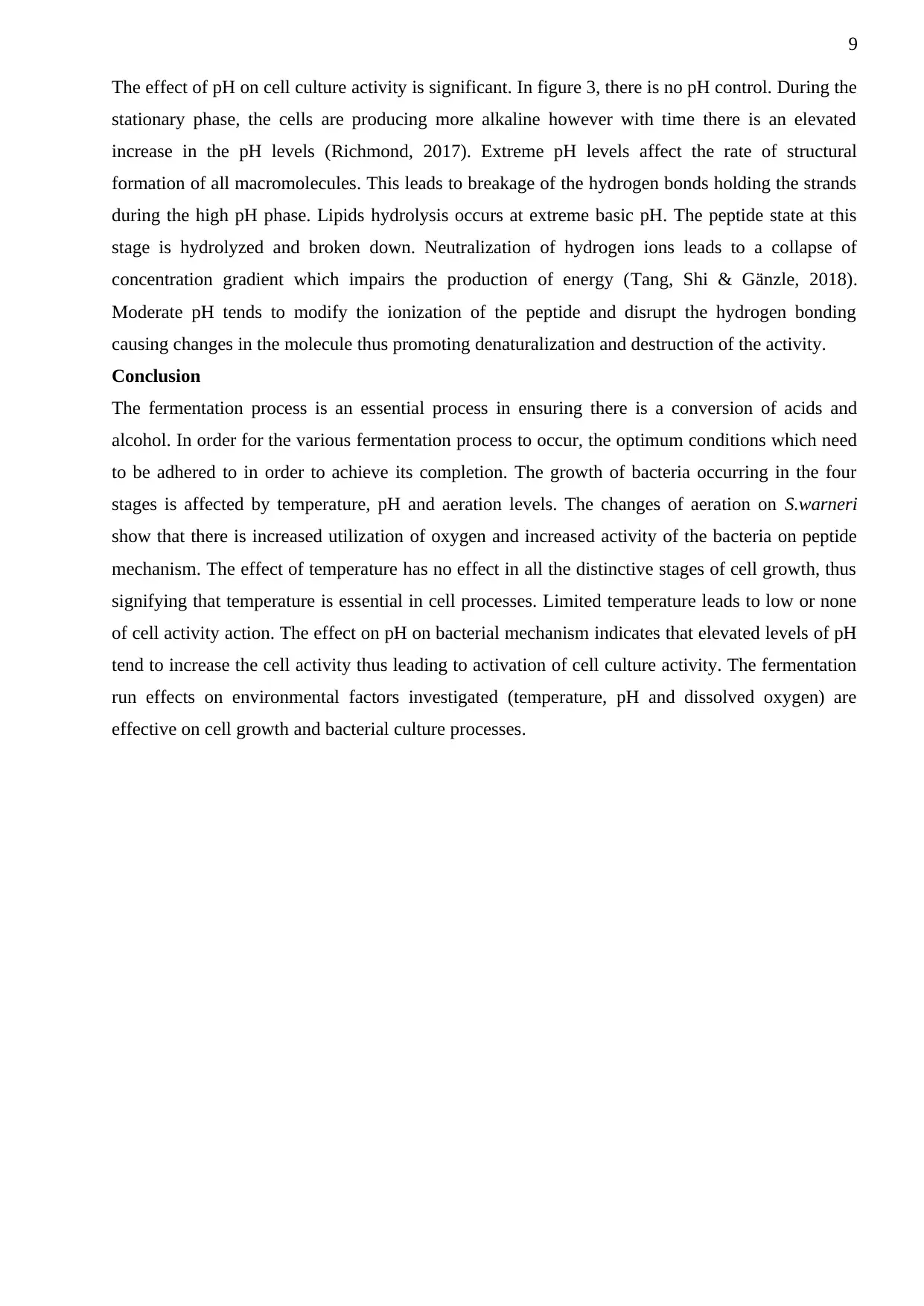
9
The effect of pH on cell culture activity is significant. In figure 3, there is no pH control. During the
stationary phase, the cells are producing more alkaline however with time there is an elevated
increase in the pH levels (Richmond, 2017). Extreme pH levels affect the rate of structural
formation of all macromolecules. This leads to breakage of the hydrogen bonds holding the strands
during the high pH phase. Lipids hydrolysis occurs at extreme basic pH. The peptide state at this
stage is hydrolyzed and broken down. Neutralization of hydrogen ions leads to a collapse of
concentration gradient which impairs the production of energy (Tang, Shi & Gänzle, 2018).
Moderate pH tends to modify the ionization of the peptide and disrupt the hydrogen bonding
causing changes in the molecule thus promoting denaturalization and destruction of the activity.
Conclusion
The fermentation process is an essential process in ensuring there is a conversion of acids and
alcohol. In order for the various fermentation process to occur, the optimum conditions which need
to be adhered to in order to achieve its completion. The growth of bacteria occurring in the four
stages is affected by temperature, pH and aeration levels. The changes of aeration on S.warneri
show that there is increased utilization of oxygen and increased activity of the bacteria on peptide
mechanism. The effect of temperature has no effect in all the distinctive stages of cell growth, thus
signifying that temperature is essential in cell processes. Limited temperature leads to low or none
of cell activity action. The effect on pH on bacterial mechanism indicates that elevated levels of pH
tend to increase the cell activity thus leading to activation of cell culture activity. The fermentation
run effects on environmental factors investigated (temperature, pH and dissolved oxygen) are
effective on cell growth and bacterial culture processes.
The effect of pH on cell culture activity is significant. In figure 3, there is no pH control. During the
stationary phase, the cells are producing more alkaline however with time there is an elevated
increase in the pH levels (Richmond, 2017). Extreme pH levels affect the rate of structural
formation of all macromolecules. This leads to breakage of the hydrogen bonds holding the strands
during the high pH phase. Lipids hydrolysis occurs at extreme basic pH. The peptide state at this
stage is hydrolyzed and broken down. Neutralization of hydrogen ions leads to a collapse of
concentration gradient which impairs the production of energy (Tang, Shi & Gänzle, 2018).
Moderate pH tends to modify the ionization of the peptide and disrupt the hydrogen bonding
causing changes in the molecule thus promoting denaturalization and destruction of the activity.
Conclusion
The fermentation process is an essential process in ensuring there is a conversion of acids and
alcohol. In order for the various fermentation process to occur, the optimum conditions which need
to be adhered to in order to achieve its completion. The growth of bacteria occurring in the four
stages is affected by temperature, pH and aeration levels. The changes of aeration on S.warneri
show that there is increased utilization of oxygen and increased activity of the bacteria on peptide
mechanism. The effect of temperature has no effect in all the distinctive stages of cell growth, thus
signifying that temperature is essential in cell processes. Limited temperature leads to low or none
of cell activity action. The effect on pH on bacterial mechanism indicates that elevated levels of pH
tend to increase the cell activity thus leading to activation of cell culture activity. The fermentation
run effects on environmental factors investigated (temperature, pH and dissolved oxygen) are
effective on cell growth and bacterial culture processes.
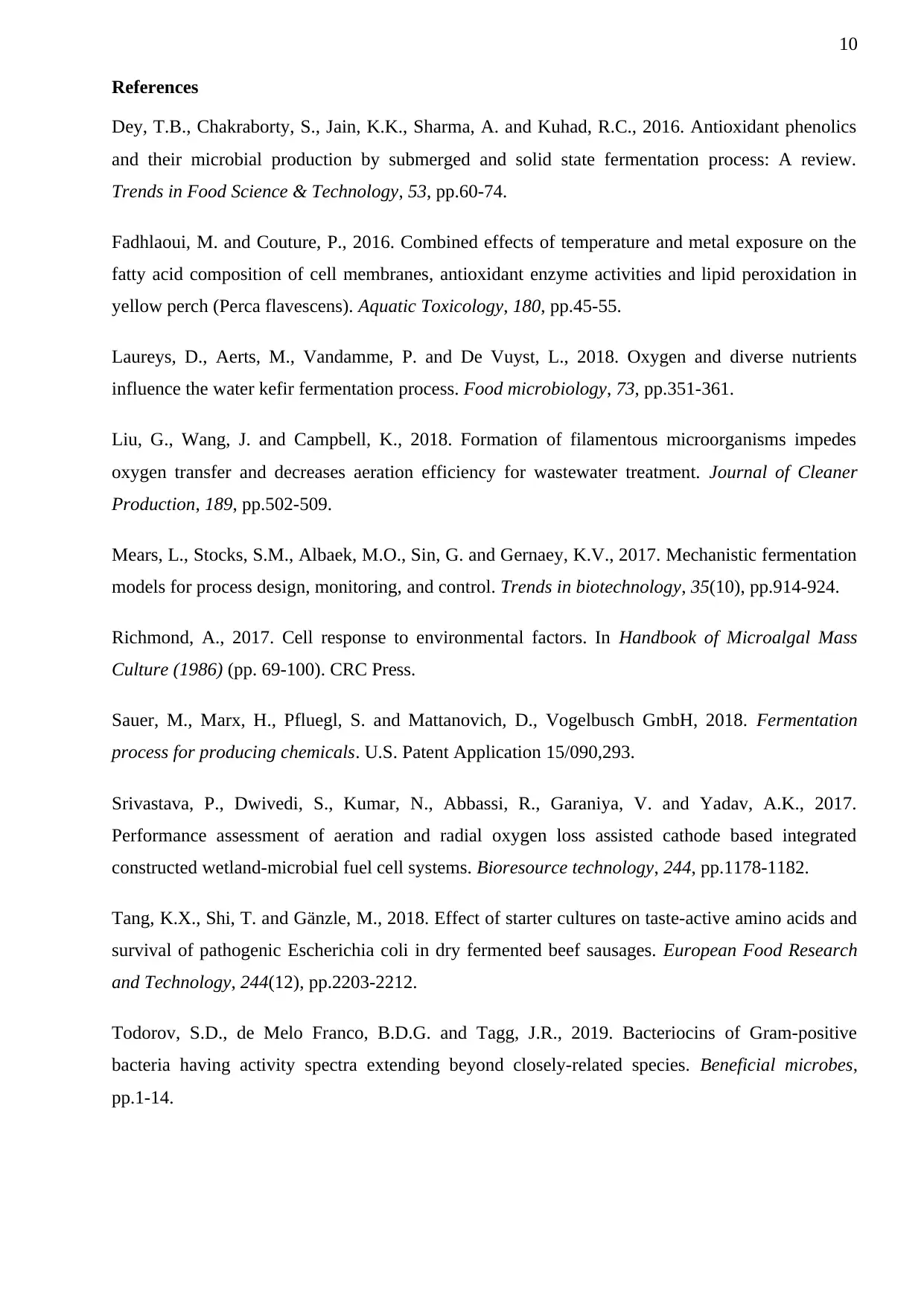
10
References
Dey, T.B., Chakraborty, S., Jain, K.K., Sharma, A. and Kuhad, R.C., 2016. Antioxidant phenolics
and their microbial production by submerged and solid state fermentation process: A review.
Trends in Food Science & Technology, 53, pp.60-74.
Fadhlaoui, M. and Couture, P., 2016. Combined effects of temperature and metal exposure on the
fatty acid composition of cell membranes, antioxidant enzyme activities and lipid peroxidation in
yellow perch (Perca flavescens). Aquatic Toxicology, 180, pp.45-55.
Laureys, D., Aerts, M., Vandamme, P. and De Vuyst, L., 2018. Oxygen and diverse nutrients
influence the water kefir fermentation process. Food microbiology, 73, pp.351-361.
Liu, G., Wang, J. and Campbell, K., 2018. Formation of filamentous microorganisms impedes
oxygen transfer and decreases aeration efficiency for wastewater treatment. Journal of Cleaner
Production, 189, pp.502-509.
Mears, L., Stocks, S.M., Albaek, M.O., Sin, G. and Gernaey, K.V., 2017. Mechanistic fermentation
models for process design, monitoring, and control. Trends in biotechnology, 35(10), pp.914-924.
Richmond, A., 2017. Cell response to environmental factors. In Handbook of Microalgal Mass
Culture (1986) (pp. 69-100). CRC Press.
Sauer, M., Marx, H., Pfluegl, S. and Mattanovich, D., Vogelbusch GmbH, 2018. Fermentation
process for producing chemicals. U.S. Patent Application 15/090,293.
Srivastava, P., Dwivedi, S., Kumar, N., Abbassi, R., Garaniya, V. and Yadav, A.K., 2017.
Performance assessment of aeration and radial oxygen loss assisted cathode based integrated
constructed wetland-microbial fuel cell systems. Bioresource technology, 244, pp.1178-1182.
Tang, K.X., Shi, T. and Gänzle, M., 2018. Effect of starter cultures on taste-active amino acids and
survival of pathogenic Escherichia coli in dry fermented beef sausages. European Food Research
and Technology, 244(12), pp.2203-2212.
Todorov, S.D., de Melo Franco, B.D.G. and Tagg, J.R., 2019. Bacteriocins of Gram-positive
bacteria having activity spectra extending beyond closely-related species. Beneficial microbes,
pp.1-14.
References
Dey, T.B., Chakraborty, S., Jain, K.K., Sharma, A. and Kuhad, R.C., 2016. Antioxidant phenolics
and their microbial production by submerged and solid state fermentation process: A review.
Trends in Food Science & Technology, 53, pp.60-74.
Fadhlaoui, M. and Couture, P., 2016. Combined effects of temperature and metal exposure on the
fatty acid composition of cell membranes, antioxidant enzyme activities and lipid peroxidation in
yellow perch (Perca flavescens). Aquatic Toxicology, 180, pp.45-55.
Laureys, D., Aerts, M., Vandamme, P. and De Vuyst, L., 2018. Oxygen and diverse nutrients
influence the water kefir fermentation process. Food microbiology, 73, pp.351-361.
Liu, G., Wang, J. and Campbell, K., 2018. Formation of filamentous microorganisms impedes
oxygen transfer and decreases aeration efficiency for wastewater treatment. Journal of Cleaner
Production, 189, pp.502-509.
Mears, L., Stocks, S.M., Albaek, M.O., Sin, G. and Gernaey, K.V., 2017. Mechanistic fermentation
models for process design, monitoring, and control. Trends in biotechnology, 35(10), pp.914-924.
Richmond, A., 2017. Cell response to environmental factors. In Handbook of Microalgal Mass
Culture (1986) (pp. 69-100). CRC Press.
Sauer, M., Marx, H., Pfluegl, S. and Mattanovich, D., Vogelbusch GmbH, 2018. Fermentation
process for producing chemicals. U.S. Patent Application 15/090,293.
Srivastava, P., Dwivedi, S., Kumar, N., Abbassi, R., Garaniya, V. and Yadav, A.K., 2017.
Performance assessment of aeration and radial oxygen loss assisted cathode based integrated
constructed wetland-microbial fuel cell systems. Bioresource technology, 244, pp.1178-1182.
Tang, K.X., Shi, T. and Gänzle, M., 2018. Effect of starter cultures on taste-active amino acids and
survival of pathogenic Escherichia coli in dry fermented beef sausages. European Food Research
and Technology, 244(12), pp.2203-2212.
Todorov, S.D., de Melo Franco, B.D.G. and Tagg, J.R., 2019. Bacteriocins of Gram-positive
bacteria having activity spectra extending beyond closely-related species. Beneficial microbes,
pp.1-14.
1 out of 10
Your All-in-One AI-Powered Toolkit for Academic Success.
+13062052269
info@desklib.com
Available 24*7 on WhatsApp / Email
![[object Object]](/_next/static/media/star-bottom.7253800d.svg)
Unlock your academic potential
© 2024 | Zucol Services PVT LTD | All rights reserved.